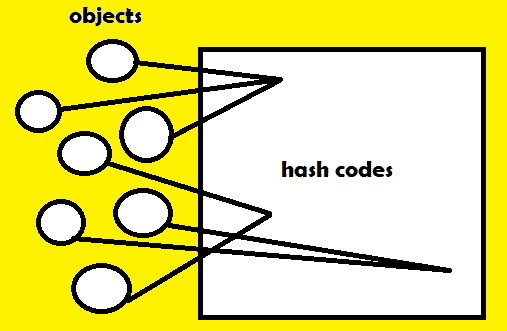Java java.lang.Object中的超类提供了两种比较对象的重要方法:equals()和hashcode()。当面对实现类之间的交互时,这些方法被广泛使用。 在本教程中,我们仅看一下hashCode()。

方法定义与实现
hashCode():默认情况下,此方法返回每次都是唯一的随机整数。 例如,如果第二次执行应用程序,则该值将不同。hashCode值主要用于哈希格式的集合中,例如 HashSet,HashMap等。请注意,在覆盖equals()方法的每个类中都必须覆盖此方法。

hashCode的简单说明
hashCode()可以使用的集合列表
什么时候应该使用hashCode()方法
如果我们想执行equals()方法,则需要确保这些对象具有相同的唯一哈希码 ID。当哈希码 ID 不同时,我们永远不要执行equals()。
注意:当hashCode()比较返回假时,equals()方法还必须返回假。 如果哈希码不同,则对象不等。
hashCode()和equals()的实际示例
import java.lang.*;public class hashCodeExample {public static void main(String[] args){Car BMW = new Car(1, "BMW"); // 1 --> ID, 2 --> the name of the car brandCar mercedes = new Car(2, "Mercedes"); // 1 --> ID, 2 --> the name of the car brandboolean isHashcodeEqual = BMW.hashCode() == mercedes.hashCode();if (isHashcodeEqual) {System.out.println("Equal");} else {System.out.println("No need to compare with equals() method as it is clear " +"that the id of these objects is not equal.");}}static class Car {int id;String brand;public Car (int id, String brand) {this.id = id;this.brand = brand;}@Overridepublic boolean equals(Object obj) {if(this == obj) {return true;}else if(obj == null || getClass() != obj.getClass()) {return false;}Car car = (Car) obj;return id == car.id && brand.equals(car.brand);}@Overridepublic int hashCode() {return id;}}}
上面代码的简要分解
在前几行中,我们将创建两个Car对象,并传递一个id和一个品牌名称。
Car BMW = new Car(1, "BMW"); // 1 --> ID, 2 --> the name of the car brandCar mercedes = new Car(2, "Mercedes"); // 1 --> ID, 2 --> the name of the car brand
然后,我们将一个布尔值存储在名为isHashCodeEqual的变量中,该变量根据两个对象的 ID 是否相等而为true或false。
boolean isHashcodeEqual = BMW.hashCode() == mercedes.hashCode();
在那之后,我们有一个条件可以检查isHashCodeEqual是true还是false。 如果为true,则表示两个对象的 ID 相等。 如果不是,则意味着相反。 如果它们相等,我们只需打印“相等”。 如果不是,我们将打印一条有用的消息,该消息基本上会说,如果它们不相等,则无需使用相等进行检查,因为这两个对象不共享相同的 ID。
if (isHashcodeEqual) {System.out.println("Equal");} else {System.out.println("No need to compare with equals() method as it is clear " +"that the id of these objects is not equal.");}
接下来是我们的静态类Car。
static class Car {int id;String brand;public Car (int id, String brand) {this.id = id;this.brand = brand;}@Overridepublic boolean equals(Object obj) {if(this == obj) {return true;}else if(obj == null || getClass() != obj.getClass()) {return false;}Car audi = (Car) obj;return id == audi.id && brand.equals(audi.brand);}@Overridepublic int hashCode() {return id;}}
hashCode()的常见错误
- 在
hashCode()方法中返回一个常量值,而不是为每个对象返回唯一的值。 - 使用
HashMap之类的哈希集合时,不覆盖equals()和hashCode()。 - 忘记使用
equals()方法或其他方法覆盖hashCode()。
有关hashCode()的重要注意事项
- 使用有效的算法,以便生成唯一的哈希码
- 覆盖
equals()方法时,请始终确保也覆盖了hashCode()方法。 - 如果比较两个对象的哈希码的结果为
false,则equals()方法也应为false。 (请参见上面的代码示例) - 如果在起诉哈希集合时没有覆盖
equals()和hashCode(),则该集合将具有重复项。

